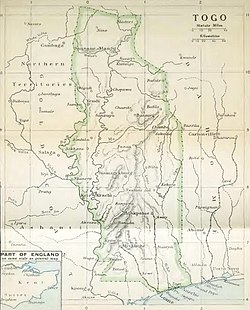
Back حملة توغولاند Arabic Тагалендская кампанія Byelorussian Campanya de Togolàndia Catalan Togo im Ersten Weltkrieg German Campaña de Togolandia Spanish Campagne militaire du Togoland French כיבוש טוגולנד HE Togo az első világháborúban Hungarian Kampanye militer Togoland ID Kampania togijska Polish
| Togoland campaign | |||||||||
|---|---|---|---|---|---|---|---|---|---|
| Part of the African theatre of World War I | |||||||||
 Togoland in 1914 | |||||||||
| |||||||||
| Belligerents | |||||||||
| Commanders and leaders | |||||||||
|
Frederick Bryant Jean Maroix |
Hans von Doering Georg Pfähler † | ||||||||
| Units involved | |||||||||
|
Gold Coast Regiment Tirailleurs Senegalais | Paramilitary and police forces | ||||||||
| Strength | |||||||||
|
British: 600 French: 500 |
693–1,500 (including reservists) | ||||||||
| Casualties and losses | |||||||||
|
British: 83 French: c. 54 | 41 | ||||||||
The Togoland campaign (6–26 August 1914) was a French and British invasion of the German colony of Togoland in West Africa, which began the West African campaign of the First World War. German colonial forces withdrew from the capital Lomé and the coastal province to fight delaying actions on the route north to Kamina, where the Kamina Funkstation (wireless transmitter) linked the government in Berlin to Togoland, the Atlantic and South America.
The main British and French force from the neighbouring colonies of Gold Coast and Dahomey (part of French West Africa) advanced from the coast up the road and railway, as smaller forces converged on Kamina from the north. The German defenders delayed the invaders for several days at the Affair of Agbeluvoe (affair, an action or engagement not of sufficient magnitude to be called a battle) and the Affair of Khra but surrendered the colony on 26 August 1914. In 1916, Togoland was partitioned by the victors and in July 1922, British Togoland and French Togoland were established as League of Nations mandates.